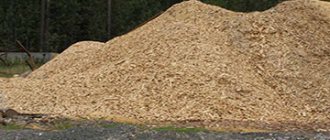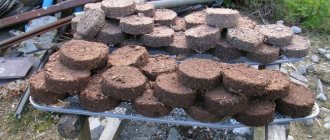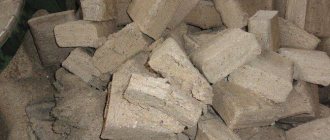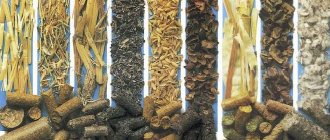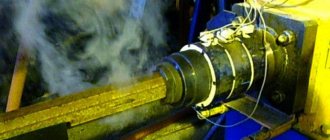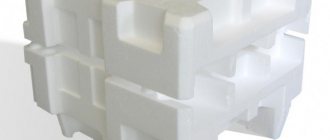The problem of complete waste disposal has long been dealt with in various fields of activity.
The goal of using forest waste 100% has not yet been achieved.
Fuel pellets and briquettes obtained from wood waste make it possible to achieve this already in our time.
Processing of timber, sawing and processing waste has never been so pressing before, except in those regions where there is no commercial timber left at all.
Today, the introduction of new technologies for deep processing of wood waste is becoming increasingly profitable.
Types of pellets
For the production of pellets, as mentioned above, various wastes are used:
- sawdust and shavings;
- bark, tree branches, dry leaves and needles;
- straw;
- wheat, rice and buckwheat husks;
- sunflower husk;
- fine fractions of peat and coal;
- paper and cardboard.
Pellets are produced from waste from the woodworking and agricultural industries
If we compare pellets made from different materials according to their degree of energy efficiency and ash content, then the highest quality are those made from wood processing waste - sawdust and shavings. It should be borne in mind that the presence of foreign impurities in the sawdust mass (such as tree bark and leaves) reduces the quality characteristics of the pellets.
Fuel briquettes offered on the domestic market are divided into two main types, each of which has certain quality characteristics. Private consumers use pellets mainly of the first grade, which are granules with a diameter of 4–8 mm, made from wood waste cleared of foreign impurities. When fuel briquettes burn, as a result of which they release 4.7 kW of thermal energy per hour, no more than 1.5% of ash remains. Such pellets can be used both for their intended purpose - for heating residential premises, and as a filler for cat litter.
Premium quality pellets are light yellow or even completely white in color.
Industrial grade pellets with a diameter of up to 12 mm are made from raw materials that may contain old and low-grade wood, bark, leaves, etc. The thermal performance of pellets of this grade, the ash content of which is in the range of 1.5–5%, is not exceeds 4 kW. Taking into account the low energy efficiency, it is advisable to use pellets of this type only in industrial boilers.
Industrial pellets are gray-brown in color due to the high content of bark and other impurities
The quality of the raw material (in particular, its density and humidity level) also affects the yield of the finished product - fuel pellets. So, if sawdust and shavings are used for pellets, the moisture content of which is in the range of 6–13%, then to produce one ton of briquettes you will need about 2.3 dense cubic meters of raw material, which is approximately 1.15 tons in mass terms. Accordingly, if the density of the source material is lower and the humidity is higher, then more of it will be required for the production of pellets.
Video on the topic of the article: how to quickly check the quality of pellets at home.
Working principle of a drum dryer
So, chips and sawdust are loaded into the chamber and begin to move at an angle down the walls towards the unloading compartment. The internal blades and reliefs of the drum break up compacted lumps of raw materials. From the combustion chamber or from the heat generator, a gas-air mixture heated to 600-700 °C is pumped into the cylinder. It pours over the material and heats it. Moisture continuously evaporates. The dried material is unloaded through the hatch. After passing through the chamber, the gases are cooled to a temperature of 80-120 ° C and then sent to the cyclone. There they release wood dust and air pollutants.
One operator is required to control drying. It is necessary to monitor the balance of temperature and volume of the wood fraction: with increased t, more chips are supplied or t at the inlet is reduced. And vice versa, when t at the output is below average, the operator increases it at the input or reduces the volume of chips.
Advantages of wood chip dryers
The drum dryer for bulk materials is the undoubted leader in its class. This technology is used traditionally, it is well studied and does not promise any unpleasant surprises to the owner of a pellet business.
Disadvantages of a drum dryer
The disadvantages of the unit are usually its large size. Such a structure is not easy to transport and install in the general circuit of the complex. Problems with dimensions are solved with the help of sectional structures, which make it easy to transport and assemble the drum at the installation site.
Another disadvantage is the high price of the device due to the metal consumption and complexity of production.
Production technology
The process of producing pellets in production is very long, so some entrepreneurs are afraid to take on this business. But these are meaningless worries, as crushed sawdust does not deteriorate and is in high demand.
Production technology:
- The prepared raw materials are processed and sent to a crusher for grinding. This point is mandatory, otherwise the entire production of pellets will stall due to the breakdown of the granulator. Sawdust should be stored in a special container to prevent debris from getting on it.
- After crushing the wood, the crushed raw materials are sent to the dryer, where the moisture content of the sawdust is reduced to 12%. This item is the most expensive, but without it the pellets will rot or produce a low level of heat. 1 MW of energy is enough to dry the entire batch. Experienced manufacturers recommend burning waste left over from production in dryer compartments. If the sawdust humidity drops below 10, then the raw material is irrigated with steam or dispersion water.
- Next, sawdust is pressed using a special apparatus. Production volumes will depend on the size of the matrix - it can be flat or cylindrical.
- During pressing in the granulator, the pellets heat up and need to be cooled to improve the quality of the product.
- The final stage is sorting and packaging the resulting granules. Bags for pellets must be sealed to prevent water from getting into them during transportation. Recommended size: 20 – 25 kg per bag.
Manufacturers recommend using a cylindrical matrix in the granulator during production so that the final product is larger in size and the productivity of the equipment is higher. In a flat matrix, the pellets will be mini-sized, and their quantity will only be enough for personal use.
Types of pellet machines
There are 4 types of granulators.
Screw granulator
- the simplest, homemade machine for pellets. In essence, it is a large meat grinder with a drive: inside there is a feed auger that pushes chopped sawdust through the grate. Such devices are not mass-produced; they are completely homemade. There is no cutting mechanism on the outside of the matrix, so the granules fall off under their own weight. Typically, this design is used for mixed feed, especially since the diameter of the granule is too small for fuel pellets. However, some craftsmen press wood pellets on screw extruders.
Household Flat Die Granulator
- the most common in small production. Operating principle: crushed sawdust is fed vertically directly into the pressing chamber, the bottom of which is a flat, disc-shaped matrix. In the center there is an axis with 2-3 rollers, which move around the matrix in a circle and roll the material down into the holes (dies). The finished granules come out from below, on the other side of the disk. The production of the device depends on the diameter of the matrix and the size of the rollers. Household pelletizers operate at relatively low pressure and temperature, and the pellets do not require forced cooling.
Industrial Flat Die Granulator
– a device of a higher level, higher in power and performance. Typically the entire apparatus is cylindrical in shape. The production and diameter of the dies vary: the well-known Amandus Kahl devices have a diameter from 175 to 1250 mm, and engine power from 22 to 500 kW. Also, industrial machines for the production of sawdust pellets with a disk-shaped matrix are produced in China.
Industrial granulator with ring matrix OGM or DG
– the most common device in pellet factories. There are several reasons for this - high productivity, simplicity of the internal mechanism, high quality of the resulting granules. Pressing begins at the moment the wood pulp is clamped between the inner surface of the rotating matrix and the rolling press roller. The raw material passes through the dies under pressure. The process takes place at a temperature of 250-300 C, so the granules come out of the dies very hot. After pressing, they are sent to a cooling column.
The ring matrix is ideally selected for each type of wood or agricultural raw material.
Review of equipment models
Cost of an incomplete line: 4,500,000 rubles
Accessories:
- Crusher for small fractions. Model: DM27 AND DM35. Power: 35.5 kW. Cost at purchase price: 500,000 rubles.
- Dryer. Model: TYT-1300 or FET-RC1121. Performance: 9 kW. Dries up to 11,500 kg Dryer. Power: 50 kW. Warm air temperature up to 300 degrees. Removing moisture from 2,000 kg of granules per hour. Cost: 2,000,000 rubles.
- Granulator from a Chinese manufacturer. Model: SKJ550 or KL600 with a power of 55 kW. Product diameter from 10 mm. Cost: 1,000,000 rubles.
- Cooler. Model: SKLN4. Cost: 1,000,000. Cools up to 2,300 kg of pellets per hour. Power of the ventilated mechanism: 20 kW. With a 2 year warranty.
The cost of models is indicated without VAT and installation costs. For dryers and coolers, the indicators are given taking into account a humidity of no more than 50% for all products.
Drum dryer structure
The drum is a horizontally mounted cylinder made of sheet steel up to 2 cm thick. It can be 1 to 3 meters in diameter. The length of the cylinder is from 6 meters. The device is often installed with a slope of 3-5% on support rollers. One of the videos is equipped with a controller that notifies you when the camera position changes. On one side, a combustion unit is connected to the chamber, on the other side, the unloading chamber receives the material.
The rotation of the drum is carried out using a ring gear fixed in the middle of the chamber, which is connected to the drive gear and drive. The device makes up to 8 full revolutions per minute. Inside, drums of various designs can have a relief, mixers, protrusions that help stir up raw materials, break up compacted lumps, and move them forward to the unloading hatch.
The design of drum dryers involves external loading of bulk materials. For this purpose, screw or scraper conveyors are usually used.
Dryer drum: video diagram of the drying complex
Machine for the production of sawdust pellets: what do you need to know before buying?
Before directly purchasing everything necessary to create a wood pellet production business, you should calculate all the nuances of the future business, evaluate all its advantages, and carefully consider all its shortcomings and problems.
Equipment (mini machine) for producing pellets
You should carefully study all the equipment necessary for this task, calculate which one is suitable specifically for your premises, your future operating mode. In this case, it is necessary to prepare the room itself: its dimensions must be at least two hundred square meters, while the required height of this room should not be less than ten meters.
It must be possible to supply electricity and have a normal access road. It is also necessary to select future personnel in advance, so that after installation of the equipment there is no downtime. It should be taken into account that workers need time to study the principles of operation of this equipment.
It is necessary to consider the possibility of supplying raw materials: the best option for creating this business is the sawmill itself, in addition, you should think in advance about the markets for the finished product. In the case when pellet production is established at sawmills, the payback of the business occurs after six months of work.
How to organize a pellet production plant
Before starting an enterprise, a competent businessman will revise several business plans and make further forecasts for the development of his plant. To start building a personal file, you need to consider all the negative and positive aspects of production. And only then, to start operating the business, you need to conduct analytics on the following points:
- Identify markets
- Identify buyers;
- Assess approximate risks, costs, expenses for damaged products
- Set the cost of workers' compensation
- Identify direct competitors
- Study manufacturing technology
- Find quality equipment to purchase
- Organize a room that meets all requirements
- Find personnel and PR person
- Determine the cost of products
- Recruit a logistics team
The pellet production business is registered as “Company Name LLC.” It is worth understanding that there are now more than 150 competing factories on the market, so to get started you need to clearly think through the project and personal advantages. To increase the level of demand, it is better to develop a base abroad over time in order to obtain a certificate for international trade. Foreign markets are more in demand for Russian wood pellets, due to the lack of raw materials in their countries. In-demand enterprises sell (export) pellets abroad at 300 euros per ton of product. Today, this is the best indicator on the market.
Production requirements
To organize a personal business for production you will need:
- Devices from trusted manufacturers
- Large room with high ceilings - 5-6 meters. On average, buildings of 100 sq/m with free and spacious shipping areas are suitable for established production. The room must support a 380 V network. If there are through gates on opposite sides, then the production line should be located from one door to the other. This arrangement will reduce product processing time when packing and shipping the product. If there is one door, the line rotates 180 degrees.
- Highly qualified personnel to monitor the level of operation of the mechanisms. Working at such a plant is a labor-intensive process that requires careful monitoring of the operation of the mechanisms, so there must be at least two people at the machine. They must continually monitor production optimization and performance.
- Additional staff. Electricity, cleanliness and teamwork are the main components of the pellet production business. Therefore, the enterprise needs an electrician, a technician and a mechanic.
Is it possible to make a machine for making pellets with your own hands?
This question is asked by many people who want to start this type of business. You can make a pellet machine yourself if you have free time, some experience in metalworking and turning, patience, and the availability of the necessary funds to purchase the necessary components.
Homemade installation for making pellets
In addition, this machine, made independently, is adjusted to your wishes: the required power and the required dimensions. You will know this equipment down to the last screw, and will be able to assemble and disassemble it even with your eyes closed.
Spare parts for subsequent repairs are also made independently: therefore, the financial costs of purchasing factory components are significantly reduced.
Necessary equipment
Equipment for making pellets can be industrial or domestic, the latter is used in the production of mini-pellets for household use. The production line is driven by diesel and electric engines. A tractor shaft is also used. This is the most common option. It is capable of providing pellet equipment productivity up to 250 kg/h.
Necessary equipment for setting up a production line:
- Tenon cutter. It is designed for grinding raw materials.
- Dryer drum.
- Cooler. The device is used at the final stages of production.
- Press.
- Mill and screw mixer.
At a minimum, you will need a drying drum.
The cost of purchasing all the equipment is approximately 2 million rubles. A machine for the production of biological fuel, powered by electricity, can only be stationary. This greatly reduces the mobility of the equipment and leads to additional costs; in addition, a special place must be equipped for it, which also increases the cost.
Installations on a diesel engine and a tractor shaft have high mobility. This allows them to be placed close to the woodworking plant. This option is much more profitable, since you do not need to spend money on transporting raw materials for production to the place where the pellets are made.
A stationary industrial line is capable of producing up to a ton of pressed sawdust per hour. The cost of such equipment is about 130,000-150,000 dollars. The return on investment occurs within seven years.
Options for using sawdust
A thrifty owner will never consider sawdust to be trash, but will think about how it can be used. And here a variety of options for using this environmentally friendly material are possible:
- Sawdust is one of the best materials for heating rooms. You can even make pellets from these wood processing wastes yourself. Or press them into braces, which are perfect for the fireplace or making a fire.
- You can also insulate the ceiling when building a house or cottage using shavings. This material is inferior to all store-bought insulation materials, because analogues are not as resistant to changes in temperature and humidity. For example, synthetic insulation simply breaks down in cold weather, and sawdust helps to avoid such troubles.
- Many avid summer residents know that wood shavings are an excellent, environmentally friendly fertilizer. It is able to retain moisture and even fight weeds.
- Another way to use sawdust is possible even in a city apartment. Wood shavings make excellent bedding for pets. It also absorbs excess moisture and odors. For this purpose, sawdust is also used in private farming, for example, in a chicken coop.
- To increase the amount of smoke when smoking meat, poultry or fish, you can add slow-smoldering sawdust to the wood chips you always use. Each type of wood has a specific aroma that suits “its” product.
Technological process
Regardless of which machines are used for the production of fuel pellets, the production process consists of such technological operations as:
- Cleaning and preliminary grinding of raw materials, which are brought to such a state that the length of its particles does not exceed 2.5 mm.
- Drying sawdust mass, the humidity of which is brought to a level of 9–12%.
- Final grinding on a machine, which is carried out so that the maximum length of the particles that make up the sawdust mass does not exceed 1.5 mm.
- Mixing the crushed raw material with water or treating it with hot steam (this technological operation is used if the moisture level of the sawdust after drying and grinding has dropped below the minimum permissible value).
- Pressing the sawdust mass, as a result of which cylindrical granules are formed from it (for the practical implementation of this technological operation in a production environment, matrix installations of a cylindrical or flat type can be used; at home, homemade installations of a lever, screw or hydraulic type are suitable for the formation of fuel briquettes) .
- Cooling of finished pellets, which during their formation using high pressure spontaneously heat up to a significant temperature.
- Sorting of finished fuel pellets and their packaging.
Pellet production line
The waste generated after the implementation of the above-described technological process can be recycled. At the same time, pellets from them are created using the same algorithm.
Yandex Metrica
DIY sawdust dryer
Sawdust has many uses, but in almost all cases sawdust is required in dry form. In order to bring them to a state of dryness, we need a dryer.
Dryer at home
Such a machine can dry about 100-150 kg/hour; it consumes 550-750 V of electricity. Such a unit can produce 2.5 tons of dried sawdust per day.
Process technology
The process of drying materials is considered one of the most energy-intensive, as it requires a lot of heat. The dryer that we would like to offer you is designed for drying sawdust, wood chips and various types of small wood residues. Humidity can be reduced from 60% to 10-12%. The principle of operation of this drying apparatus is that the raw material loses weight during drying and, due to this, can move through the pipe to the cyclone, that is, without reaching the required percentage of humidity, it will not be able to move to the finished product hopper.
If your raw materials are too wet to get rid of much heat, it is better to dry them outside in the sun, or something similar.
First launch and setup
Heat the stove over medium heat for forty minutes, remove moist air and turn up the heat to high. Let's make a test batch, fill the loading hole with sawdust, depending on the temperature and dryness of the unloaded sawdust, you should select the sawdust loading speed. If the raw material does not pass from the loading hole, you should slightly block the air intake hole, or you can put a little furnace slag on the grate, which will reduce the volume of air entering inside.
Pre-launch and preventive procedures
Before each time you turn on the stove, you need to idle the system for 5-10 minutes to remove all the sawdust from the pipe. You should also check the inspection holes of the dryer every two shifts and clean the internal parts from contamination. If the fan makes shaking or cracking sounds during operation, it is likely that dirt has adhered to it, you should pause operation and clean it.
This is roughly what our dryer will look like in operation; we have different fan locations:
Safety precautions
To avoid gas leakage, stone wool gaskets should first be installed at all flange joints. For safety during installation, the exhaust fan and motor must be connected with a cord so that the fan moves clockwise. Before each start-up, you should check the base of the pipes and clean the slag holes, remove stone deposits and other contaminants.
